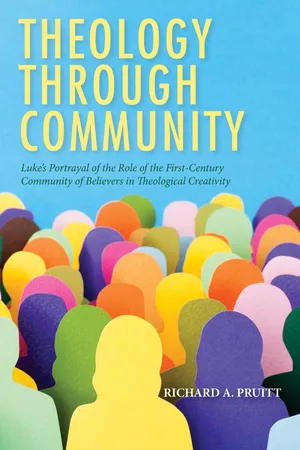
Theology through Community
Luke's Portrayal of the Role of the First-Century Community of Believers in Theological Creativity
- 162 pages
- English
- ePUB (mobile friendly)
- Available on iOS & Android
Theology through Community
Luke's Portrayal of the Role of the First-Century Community of Believers in Theological Creativity
About This Book
Since the 1980s, renewal scholars have given considerable attention to the role of the believing community in the interpretive process. A broad consensus has emerged that a triad involving Scripture, the Spirit, and the believing community forms a cooperative relationship resulting in theological development, followed by commensurate action--identified in this research as theological creativity. In the context of this research, to be creative with theology is to take an existing theological assumption and broaden or adapt it to current circumstances, given the Spirit's evidential work and a consensual understanding of Scripture. But how does the community negotiate between Spirit and Scripture without subsuming either into its own predilections? For Luke, the first-century community of believers in Acts functions as an indispensable character in the formation of theological creativity. This work will demonstrate how Luke positions the community as a character in story form, between Spirit and Scripture, functioning as a bridge through which its testimony of the Spirit's evidential work and its application of Scripture interact. In order to illustrate this balancing act, we will use a modified configuration of the triadic notion: Spirit-Community-Scripture.
Frequently asked questions
Information
Reestablishing the Twelve —Acts 1:12–26
Identifying the Community
Table of contents
- Title Page
- Preface
- Acknowledgments
- List of Abbreviations
- Introduction
- Chapter 1: Reestablishing the Twelve —Acts 1:12–26
- Chapter 2: Revealing Jesus as Servant and Son—Acts 4:23–31
- Chapter 3: Selecting the Seven—Acts 6:1–7
- Chapter 4: Accepting the Gentiles —Acts 15:1–35
- Chapter 5: Discerning the Spirit —Acts 11:27–30; 13:1–4; and 21:4, 8–14
- Chapter 6: The Community in Theological Creativity
- Appendix: Thinking Forward in Renewal Hermeneutics
- Bibliography